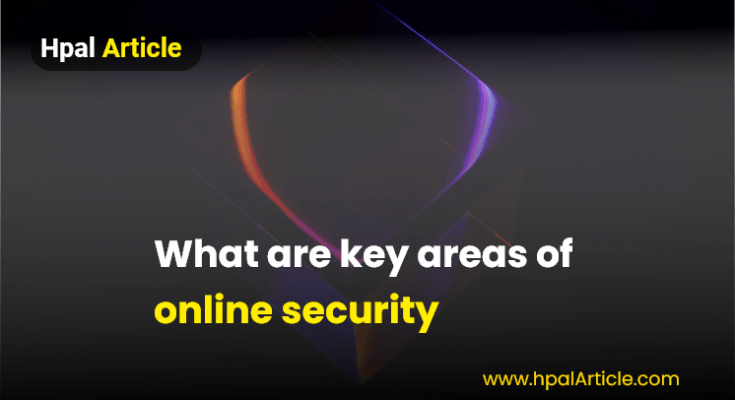Key Areas of Online Security are becoming increasingly important in today’s world. Whether you’re an individual or part of an organization, it pays to learn about the most effective strategies and techniques to keep your data secure, your identity protected, and your computer safe from threats. The following are some of the most common areas of online security.
What are key areas of online security?
- Passwords
- Mobile Security
- Website Security
- Email Security
- Password Managers
- Two-Factor Authentication
- Cloud Backup Services

1) Passwords
A strong password is your first line of defense against identity theft and attacks from hackers, who often try to guess passwords. If a hacker guesses your password correctly, you’ll never know about it; if he doesn’t guess correctly, you won’t be compromised. For example, on Twitter and Facebook, your account can be compromised simply by someone guessing your password. Passwords should be at least eight characters long with a combination of letters (upper- and lowercase), numbers, and symbols (e.g., ! % # $). Do not use words that appear in a dictionary or in any piece of published literature or news sources; also avoid using names or initials/dates associated with you personally such as pet names or birthdays.
2) Mobile Security
With so many people on their smartphones, tablets, and other mobile devices, we’re more vulnerable to hackers than ever. So what can you do to protect yourself? Make sure you have a security app installed on your phone or tablet. These free programs run in the background and will alert you when they detect suspicious activity on your device. Many also have features that can remotely lock down your mobile if it is lost or stolen, so be sure to enable those options as well.
It’s also a good idea to keep your operating system and all other software up to date. This means you will have access to any new features, fixes, or patches that may reduce your chances of being hacked. Keeping all your installed apps up to date is also important, as it ensures you’re not running on older versions that have potential security vulnerabilities. Finally, consider installing an anti-theft application on your mobile. These programs can help locate a lost or stolen device with GPS monitoring and allow you remote control over its functions via SMS commands.
3) Website Security
To ensure your website is safe from attacks, it’s important to keep all your software up-to-date. Hacking tools can be used to scan websites and identify vulnerabilities. Keeping your system current makes it easier for you to patch these vulnerabilities when they come up instead of dealing with them after an attack. There are several levels of website security, each more expensive than its predecessor but providing better protection. It is recommended that small businesses upgrade at least once a year to the next level in order to maintain current protections against new hacking threats.
Software updates are only one part of website security. While they’re essential, they don’t protect against all possible threats to your site. In addition to keeping your software current, there are other steps you can take to keep your website safe. For example, it is recommended that you use a firewall with advanced features such as intrusion detection and prevention. A firewall protects you from outside attacks and hackers on another network, while intrusion detection and prevention scan all traffic through your firewall for possible threats or unauthorized access attempts. An intrusion detection system then acts as an extra level of protection by sending you alerts when it finds suspicious activity on your network.
4) Email Security
Just as it’s important to protect your financial data, you should also be mindful of how you handle your personal information via email. Emails can be intercepted, lost, or stolen, and many people don’t think twice about clicking on a suspicious link or opening an attachment sent in an email they were expecting. To keep yourself safe from cybercrime, follow these common-sense tips: * Have complex passwords for all your accounts; those simple combinations we used to use aren’t as secure now that most everything is connected to a network.
Use a different password for each account. If you use one password for everything, then if a hacker gets access to any one of your accounts, they’ll have free rein over all your other accounts. * Be careful about where you type in passwords; malware on an infected website or even a phishing email could copy it as you type. * Make sure to use encrypted websites when entering personal information like bank details or credit card numbers. These are sometimes called HTTPS sites and will be indicated by a padlock icon when they’re secure (vs just HTTP). * Delete emails that contain sensitive information from your inbox rather than saving them in an archive folder.
5) Password Managers
According to password management firm LastPass, most people use only a handful of passwords for all their accounts. That’s great for hackers, who can get into any one account and have free rein across your devices. If you’re not already using a password manager (and if you’re not, stop reading now and sign up), there are two ways to handle them when starting new accounts
- Generate a unique password for each site
- Use that site’s built-in password generator to create strong ones
The first option will help you remember which side is which, but it means carrying around more complex passwords—and memorizing more complex passwords—for every account. The second option makes it easier to remember your login credentials, but it makes it easier for someone else to guess what they are—especially if you reuse those same weak passwords on other sites. So pick whichever method is best suited for your own brain: You’ll probably be less likely to forget or lose track of things with either method than with none at all.
6) Two-Factor Authentication
One of the first things a cybersecurity expert will tell you is to enable two-factor authentication on all your accounts. Two-factor authentication means that, after entering your password and email address, you’ll receive a text message or push notification with a special code that you have to enter before you can log in. It makes it much harder for hackers to access your accounts since they would need both your password and also access to your phone. Here’s an easy guide for enabling two-factor on Facebook, Twitter, Google, and Dropbox.
7) Cloud Backup Services
Online backup services can give you one last line of defense in case your computer (or mobile device) is ever stolen or damaged. The best services allow you to schedule regular backups, store versions in multiple places (not just one central server), and sync files between devices. That way, if your laptop dies, you’ll still have a copy stored on Dropbox. It’s also important to think about your data’s overall safety–that means making sure that your files are encrypted before they’re sent anywhere and that sensitive information like passwords aren’t saved as plain text. Some backup services even let you encrypt an entire backup with a password for added protection. You can set up all these options through a Web interface or smartphone app; there’s no need to install any software on your devices.




